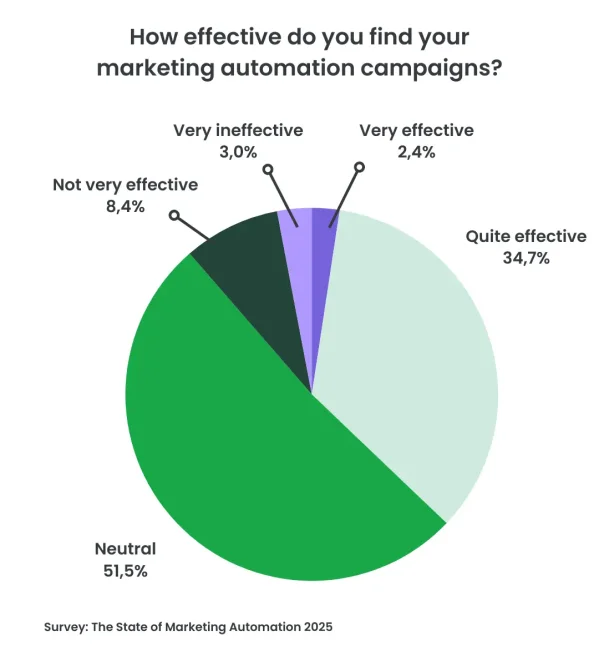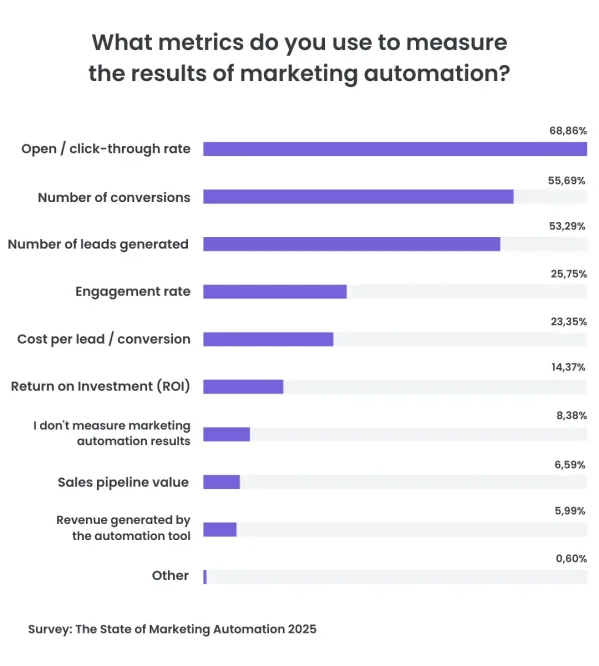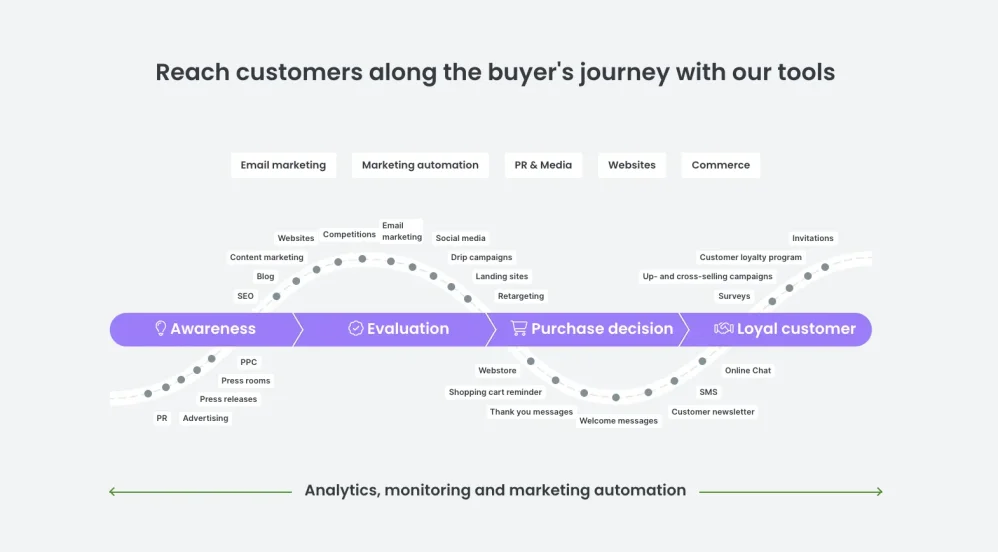The digital world generates a massive amount of data. Companies that know how to leverage this data gain a significant competitive advantage. Data-driven marketing helps you better understand your customers and offer them precisely what they need.
In this article, we explain what data-driven marketing is, why it is essential, and how marketing automation helps implement data-driven marketing.
Let's take a look at the following topics:
- What is data-driven marketing?
- Benefits of data-driven marketing
- The role of marketing automation in data-driven marketing
- The role of analytics in data-driven marketing
- Practical examples of data-driven marketing
- How to get started with data-driven marketing
- Measuring success in data-driven marketing
1. What is data-driven marketing?
Data-driven marketing refers to marketing where decisions are made based on data.
With data, marketers can better understand customer needs, interests, and behaviors. This, in turn, enables targeting messages and offers to the right customers at the right time.
Actions in data-driven marketing are measurable, which means their effectiveness can also be continuously optimized.
2. Benefits of data-driven marketing
Here’s why data-driven marketing is crucial and the significant benefits it offers across various aspects of marketing.
Better decision-making
Using data-driven marketing, you can base decisions on data and measurable outcomes rather than relying on guesses or intuition. Real-time data allows quick optimization of campaigns and concentrating budgets on channels that deliver the best results.
Data-driven approaches also provide confidence in your actions and make operations transparent and justifiable.
Improved customer understanding and satisfaction
Data enables deeper insights into customer behavior and needs. With this understanding, you can create more targeted and personalized messages and campaigns. By analyzing data, you can also anticipate customer needs, likely increasing conversions, customer satisfaction, and loyalty.
Competitive advantage and better results
Although data-based marketing may seem like a given, surprisingly, even basic aspects are often neglected. According to the Marketing Automation 2025 survey conducted by Liana, only 14% of marketing automation users utilize ROI (return on investment) to measure automation results.
Furthermore, only 16% of respondents planned to invest in measuring automation results by 2025, and 8% do not measure these results at all. These same respondents rated their campaign effectiveness as neutral or negative. Without measurement, the perceived benefit remains low.
By focusing on data-driven approaches and measurement, organizations can achieve a significant edge over competitors. Companies that use data effectively can identify trends and market opportunities before their competitors.

Measuring and utilizing data in marketing decisions provides a clear competitive advantage. For example, over half of the respondents to our Marketing Automation 2025 survey who use automation do not have a clear picture of the effectiveness of their automation campaigns.
3. The role of marketing automation in data-driven marketing
Marketing automation acts as the engine of data-driven marketing, ensuring collected data is translated into actionable steps. At the same time, automation campaigns generate new data that can be utilized across multiple channels through integrations.
How marketing automation supports data-driven marketing:
- Data collection and management: Automation tools gather data from various channels, such as websites, emails, social media, and CRM systems, providing comprehensive insights into customer behavior and preferences for data-driven campaigns. Read more about the benefits of combining marketing automation and CRM ›
- Segmentation and targeting: Automation enables customer segmentation based on behavior, demographics, or preferences, allowing targeted messaging for different segments.
- Personalization: Automation allows creating personalized customer experiences. Knowing a customer’s purchase history, preferences, and behavior helps you offer products and services tailored to them.
- Multi-channel presence and timeliness: Marketing automation facilitates consistent and simultaneous communication across various channels when it’s most relevant to the customer. This creates a seamless experience and reinforces your brand’s message.
- Automation of routine tasks: Automating routine marketing tasks, such as email campaigns, social media updates, and lead nurturing, saves time and reduces the risk of errors.
4. The role of analytics in data-driven marketing
Analytics is a critical part of data-driven marketing as it helps turn collected data into actionable insights.
Tools like Google Analytics and other reporting platforms provide a clear view of campaign effectiveness and customer behavior. These tools help identify the most effective channels and messages, enabling informed decisions to optimize marketing efforts.
Data analytics not only measures success but also forecasts the future. Predictive analytics allows businesses to respond to changes in market conditions and customer needs faster and to target marketing messages even more accurately.
5. Practical examples of data-driven marketing
Here are some examples that demonstrate the possibilities of data-driven marketing:
- Personalized email campaigns: A company can use marketing automation to send personalized emails to customers who have shown interest in a particular product but haven’t yet made a purchase. Such targeted reminders can significantly increase conversion rates.
- Multi-channel customer experiences: By utilizing data, a business can create a seamless customer experience across different marketing channels. For instance, a customer who views a product on a company’s website might see a targeted ad for the same product on social media.
- Personalized website views: Website content can be tailored based on data collected about visitors. For instance, segments from a marketing automation tool can be used in website personalization.
Data-driven marketing utilizes touchpoints throughout the customer journey across multiple channels.
6. How to get started with data-driven marketing
Here are four key steps to effectively use data in your marketing:
Assess the current situation and define goals
The first step is to assess your existing data: its sources, storage, and reliability. This will reveal any gaps that need to be filled before implementing data-driven marketing.
With a clear understanding of your data, you can set specific goals. Whether it's enhancing customer experience, boosting sales, or generating more leads, your goals will dictate the type of data you need and how it should be used.
Collect data
Customer data can be collected from various touchpoints where customers interact with your business. Examples of such data sources include:
- Website analytics
- Email marketing analytics
- Social media analytics
- Customer feedback
- Sales data
- CRM systems
- Accounting
When collecting and storing data, it’s important to adhere to responsible data practices. Companies must ensure that all customer data is collected and stored in compliance with data protection regulations such as GDPR.
Focusing on first-party data – data directly collected and owned by your company – is especially valuable. This includes data gathered directly from customers or prospects. In contrast, data obtained with the help of partners or sourced from social media platforms may not be entirely under the company’s control, and its data responsibility cannot be fully guaranteed.
It’s crucial to ensure that your company has the appropriate tools and technologies to make the most of its data. Tools such as marketing automation platforms, analytics tools, and CRM systems play a significant role in collecting, analyzing, and utilizing data effectively.
As you accumulate more data, improving its quality should also become a focus. This involves activities such as updating customer information, integrating data from various sources, and ensuring data integrity.
Utilizing data: segmentation and personalization
The next step is to use data for segmentation and personalization.
Divide your customers into segments based on demographic information, behavior, or interests. This allows for more precise targeting of marketing messages, resulting in better outcomes.
Leverage your data to create personalized campaigns. For example, you can design campaigns based on customers’ purchase histories, create tailored website views for different target audiences, or incorporate customers’ milestones into campaigns.
Optimizing data utilization
Continuously monitor the effectiveness of your marketing campaigns and optimize them as needed. Start with small experiments and test how the data-driven approach works in practice. Use A/B testing, measure results, and make ongoing improvements. This ensures that your marketing remains effective and delivers the desired outcomes.
7. Measuring success in data-driven marketing
Measuring the success of data-driven marketing requires selecting the right metrics. These metrics depend largely on the company’s goals and marketing channels, but some commonly used ones include:
- Conversion rate: The percentage of targeted customers who take the desired action, such as making a purchase or contacting the company.
- Return on investment (ROI): The revenue generated by a campaign in relation to its costs.
- Lead quality: Are the leads relevant and likely to become customers? How many leads from a campaign convert into paying customers?
- Cost per acquisition (CPA): The cost of acquiring a single customer.
- Net promoter score (NPS): Measures customer satisfaction and their likelihood to recommend your company to others.
For instance, based on our Marketing Automation 2025 survey, the most commonly used metrics in marketing automation include open/click rates (69% of users), number of conversions (56%) and the number of generated leads (53%).

While everything in data-driven marketing can theoretically be measured, it’s particularly important at the start to focus on a few key metrics that will track your progress toward your goals effectively.
LianaAutomation: the cornerstone of data-driven marketing
The agile marketing automation tool LianaAutomation serves as the engine of data-driven marketing, transforming collected data into actionable, targeted actions.
Create automated customer segments, execute tailored, data-driven campaigns for your target audiences, and leverage opportunities for upselling and cross-selling with maximum efficiency.




